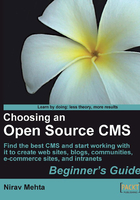
Understanding technical requirements
Let us say that you bought the car you took for a test drive last time. You have a superb audio system in your current car and you want to get that set up in the new car. You tell the mechanic to do that. But he grins at you and says, "If you wanted to fit that audio system, you should have bought the DX version, not the EX."
Ouch! That hurt!
Going ahead with a CMS purely by its demo can hurt even more. If you already have a web site or other systems, you must understand technical requirements of the CMS you are shortlisting. You should then compare those requirements with your existing setup and see if they fit.
Most open source CMSs use PHP as the server-side programming language and MySQL as the database. Typically, they are hosted on Linux servers with Apache as the web server. If your hosting company provides these (most probably they do), you are fine.
Note
Of course, there are powerful open source CMSs in Java, Python, Ruby, and other languages too. Some also use PostgreSQL or flat file databases. The combination of Linux, Apache, MySQL, and PHP is commonly referred to as LAMP stack. Apache, MySQL, and PHP also work very well on Windows and Mac OS.
Wordpress, a popular blog engine, is also a feature-rich content management system. It's easy to use and famous for its quick five-minute installation. Let's use Wordpress for the next few exercises. We will also get familiar with one more CMS.
So are you ready? Let's get techy!